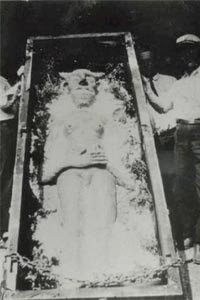While in the army, “Cruise” saw huge, monstrous statues and upon his return to Tennessee, he decided to create his own sculpture. Using bed clay located near an abandoned coal mine, he painstakingly made a detailed figure, spending years on detail work. With horns, a large head, and long arms, the figure appeared so vicious that Sexton fashioned a chain around the creature’s neck. Wings reached almost to its feet. Twenty-four teeth were visible in large mouth. The statue even sported clay genitals.
Fearing her son had a still hidden in the woods, Cruise’s mother followed him to the mine. (From what I’ve heard, moonshine was a popular way for some of the Tennessee Sextons to get a little extra cash.) Instead of liquor, Mom found a “demon” who frightened her so much that she started spreading the story of the horrible monster she’d seen. And our good, old boy figured the tales circulating could be profitable. He made up a story claiming that the creature had been found in July of 1921, under five feet of dirt in his backyard. He said that his belief was that he had unearthed an ancient idol.
As the story of the devil spread, Sexton and his brother,Jerry Smith, put the devil in an oversized coffin and carried it to Jerry’s yard in town. Some said the creature weighed a ton, others claimed only five hundred pounds, but which ever it was, transporting it must have been a difficult task. Not so surprisingly, with a little help from Sexton, I’m sure, the tale of the demon became more exaggerated, and it was taken to Helenwood Railway Station where it was displayed. Twenty-five cents bought twenty-five minutes of viewing. By August of 1921, there was so much notoriety that the New York Times wrote two articles. People nationwide were travelling the rails to see Sexton's creation.
In September of 1921, J.C. Pemberton of nearby Oneida, Tennessee paid two thousand dollars for the monster and immediately showed it in the Somerset Fair in Somerset, Kentucky. The demon was the top draw at the fair. A professor from an “Eastern School” espoused that the statue was an idol from an early race. Cruise signed an affidavit stating that the statue was authentic while a guard watched over the casket now reinforced with four iron bands. Some supposedly fainted at the viewings, others claimed the demon was a fake. However, despite cries of fraud, Pemberton was able to bargain for a reported twenty-five thousand dollars sale to parties who showed it at the Chicago World’s Fair of 1923.
After the Fair, the devil didn’t return to Scott County. Some said that it was put on display on in a small museum in the Northern United States. Others said it disintegrated.
For some odd reason (were people that naïve?), Cruise Sexton was never pegged as the source of the monster. Residents of Cruise’s hometown decided that the devil had visited their hometown because of the sins of the people who lived there. They pointed to the drinking, saloons, and violence as evidence and soon the little town was called “Hell in the Woods.” The name stuck.
 |
| Chart showing the relationship between my grandmother, Nancy Belle Waters, and Robinson Crusoe Sexton |
It would be wonderful if the stories I find had enough details to exactly pinpoint the people involved, especially the eccentric ones. However, many times, it comes down to a presumption and a hope that someone will help correct mistakes.
I glanced down a record of military actions in China to see if I could determine which “Cruise” started his own lucrative business in an abandoned coal mine. In this case, an uncle, named Reuben Crusoe Sexton (b. 1872), and his nephew, Crusoe Reuben (b.1896) are the two most likely entrepreneurs. American soldiers were in China from the 1890’s to 1918. So either one could have visited there. As this tale dates from 1921, I thought that the younger came back from World War I, worked on the statue for three years, and then started selling tickets. On the other hand, I remember seeing somewhere that Sexton worked on it for seven years. If that is the case, the younger is ruled out. Also, Jerry Smith helped Cruise take his monster to town (and here I envision them dressing the creature in tails and a tophat). Jerry Smith was a brother to the elder, the two shared a mother. If I were to hang out and do something a little shady, my more likely companion would be my sibling, not my uncle. So, this account is written assuming the uncle was the sculptor.
-Cheri



Cruise's grandson is trying to find out more about this- his aunt had an original picture of the devil...let me know if you'd like to connect
ReplyDelete